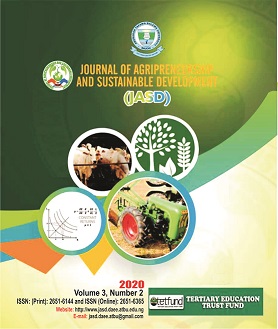ECONOMIC ANALYSIS OF FUEL WOOD CONSUMPTION IN GUMA LOCAL GOVERNMENT AREA OF BENUE STATE, NIGERIA
DOI:
https://doi.org/10.59331/jasd.v3i2.122Keywords:
Fuel Wood, Consumption, Demand, Economic analysis, EnergyAbstract
The study empirically investigated the economics of fuel wood consumption in Guma Local Government Area of Benue State. Multi stage sampling technique was used to select respondents for the study. Data for the study were obtained from primary source using a well-structured questionnaire. Data collected were analyzed using descriptive statistics and regression analysis. The study found out that; there were more male (75.0%) fuel wood consumers than female (25%) fuel wood consumers in the study area, majority (33.3%) of consumers were aged between 21-40 years and majority (75.0) were married. Most (86.7) of the farmers had one form of formal education or the other; their occupation was farming (73.3%) with 25years of fuel wood consumption experience and most (89.2%) of the farmers had average income of less than N50,000 per month. The study also established that marital status (-6221.988) and income per month (66542.580) had significant effect on fuel wood consumption and demand in the study area. The result also showed that fuel wood products was important with high demanded for cooking, rice milling, roasting of meat, fish preservation bricks production and laundry/ironing in the study area. The study therefore, recommended that Government and non-government organizations should embark on public enlightenment campaigns to inform the citizen on the consequences of fuel wood consumption such as climate change, environmental pollution, and biodiversity loss.
Downloads

Downloads
Published
How to Cite
Issue
Section
License
Copyright (c) 2022 Journal of Agripreneurship and Sustainable Development

This work is licensed under a Creative Commons Attribution 4.0 International License.






